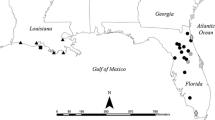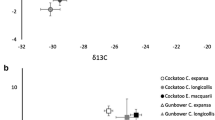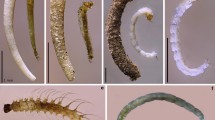Abstract
We examined how different exploratory behavioral types of largemouth bass responded to differing prey communities by determining effects on growth, survival and diet in experimental ponds. We found evidence that non-explorer largemouth bass target young-of-year bluegill early on in life, but bluegill were not an important diet item by late summer. The presence of young-of-year bluegill as prey does appear to affect the foraging strategy of the two exploring types differently. In the absence of small bluegill, both behavioral types feed primarily on benthic invertebrates and zooplankton. When small bluegill were present, we saw a shift away from zooplankton as prey for largemouth bass. However, that shift was toward more benthic invertebrates for non-exploring behavioral types and toward terrestrial insects for exploring behavioral types. Thus, it appears that prey community composition can have important effects on the way in which different behavioral types interact with their environment.




Similar content being viewed by others
References
Applegate RL, Mullan JW (1967) Food of young largemouth bass, Micropterus salmoides, in a new and old reservoir. Trans Am Fish Soc 96:74–77
Beckett DC, Aartila TP, Miller AC (1991) Contrasts in density of benthic invertebrates between macrophyte beds and open littoral patches in Eau Galle Lake Wisconsin. Am Midl Nat 127:77–90
Bell AM, Hankison SJ, Laskowski KL (2009) The repeatability of behaviour: a meta-analysis. Anim Behav 77:771–783
Benke AC, Huryn AD, Smock LA, Wallace JB (1999) Length-mass relationships for freshwater macroinvertebrates in North America with particular reference to the Southeastern United States. J N Am Benthol Soc 18:308–343
Biro PA, Post JR (2008) Rapid depletion of genotypes with fast growth and bold personality traits from harvested fish populations. Proc Natl Acad Sci 105:2919–2922
Bolnick DI, Svanback R, Fordyce JA, Yang LH, Davis JM, Hulsey CD, Forister ML (2003) The ecology of individuals: incidence and implications of individual specialization. Am Nat 161:1–28
Brenden TO, Murphy BR (2004) Experimental assessment of age-0 largemouth bass and juvenile bluegill competition in a small impoundment in Virginia. N Am J Fish Manag 24:1058–1070
Catalano MJ, Chipps SR, Bouchard MA, Wahl DH (2001) Evaluation of injectable fluorescent tags for marking centrarchid fishes: retention rate and effects on vulnerability to predation. N Am J Fish Manag 21:911–917
Chiszar D, Ashe V, Seixas A, Henderson D (1976) Social-aggressive behavior after various intervals of social isolation in bluegill sunfish (Lepomis macrochirus Rafinesque) in different states of reproductive readiness. Behav Biol 16:475–487
Costantini D, Casagrande S, Lieto GD, Fanfani A, Dell’Omo G (2005) Consistant differences in feeding habits between neighbouring breeding kestrels. Behaviour 142:1403–1415
Cote J, Fogarty S, Brodin T, Weinersmith K, Sih A (2011) Personality-dependent dispersal in the invasive mosquitfish: group composition matters. Proc R Soc Lond B 278:1670–1678
Culver DA, Boucherle MM, Bean DJ, Fletcher JW (1985) Biomass of freshwater crustacean zooplankton from length-weight regressions. Can J Fish Aquat Sci 42:1380–1390
Dall SRX, Bell AM, Bolnick DI, Ratnieks FLW (2012) An evolutionary ecology of individual differences. Ecol Lett 15:1189–1198
Daniewski W, Jezierski T (2003) Effectiveness of divergent selection for open-field activity in rabbits and correlated response for body weight and fertility. Behav Genet 33:337–345
De Robertis A, Ryer CH, Veloza A, Brodeur RD (2003) Differential effects of turbidity on prey consumption in piscivorous and planktivorous fish. Can J Fish Aquat Sci 60:1517–1526
Dingemanse NJ, Both C, Drent PJ, Tinbergen JM (2004) Fitness consequences of avian personalities in a fluctuating environment. Proc R Soc Lond B 271:847–852
Dingemanse NJ, Kazem AJN, Reale D, Wright J (2010) Behavioural reaction norms: animal personality meets individual plasticity. Trends Ecol Evol 25:81–89
Duckworth RA, Badyaev AV (2007) Coupling of dispersal and aggression facilitates the rapid range expansion of a passerine bird. Proc Natl Acad Sci 104:15017–15022
Dumont HJ, Van de Velde I, Dumont S (1975) The dry weight estimate of biomass in a selection of cladocera, copepoda and rotifera from the plankton, periphyton and benthos of continental waters. Oecologia 19:74–97
Edelaar P, Siepielski AM, Clobert J (2008) Matching habitat choice causes directed gene flow: a neglected dimension in evolution and ecology. Evolution 62:2462–2472
Einfalt LM, Wahl DH (1997) Prey selection by juvenile walleye as influenced by prey morphology and behavior. Can J Fish Aquat Sci 54:2618–2626
Farine DR, Montiglio PO, Spiegel O (2015) From individuals to groups and back: the evolutionary implications of group phenotypic composition. Trends Ecol Evol 30:609–621
Foster JR (1977) Pulsed gastric lavage: an efficient method of removing the stomach contents of live fish. Prog Fish Cult 39:166–169
Galarowicz TL, Wahl DH (2005) Foraging by a young-of-the-year piscivore: the role of predator size, prey type, and density. Can J Fish Aquat Sci 62:2330–2342
Gliwicz ZM, Slon J, Szynkarczyk I (2006) Trading safety for food: evidence from gut contents in roach and bleak captured at different distances offshore from their daytime littoral refuge. Freshw Biol 51:823–839
Griffen BD, Toscano BJ, Gatto J (2012) The role of individual behavior type in mediating indirect interactions. Ecology 93:1935–1943
Holt RD, Barfield M (2008) Habitat selection and niche conservatism. Isr J Ecol Evol 54:295–309
Howick GL, O’Brien WJ (1983) Piscivorous feeding behavior of largemouth bass: an experimental approach. Trans Am Fish Soc 112:508–516
Hoyle JA, Keast A (1987) The effect of prey morphology and size on handling time in a piscivore, the largemouth bass (Micropterus salmoides). Can J Zool 65:1972–1977
Johnson JH, Johnson EZ (1984) Comparative diets of subyearling redbreast sunfish and subyearling northern redbelly dace in an Adirondack lake. J Freshw Ecol 2:587–591
Johnson JC, Sih A (2005) Precopulatory sexual cannibalism in fishing spiders (Dolomedes triton): a role for behavioral syndromes. Behav Ecol Sociobiol 58:390–396
Lima S (1998) Stress and decision making under the risk of predation: recent developments from behavioral, reproductive, and ecological perspectives. Adv Study Behav 27:215–290
Ludsin SA, DeVries DR (1997) First-year recruitment of largemouth bass: the interdependency of early life stages. Ecol Appl 7:1024–1038
McGhee KE, Pintor LM, Bell AM (2013) Reciprocal behavioral plasticity and behavioral types during predator-prey interactions. Am Nat 182:704–717
McLaughlin RL (2001) Behavioural diversification in brook charr: adaptive responses to local conditions. J Anim Ecol 70:325–337
Miranda LE, Hubbard WD (1994) Winter survival of age-0 largemouth bass relative to size, predators, and shelter. N Am J Fish Manag 14:790–796
Mittelbach GG (1984) Predation and resource partitioning in two sunfishes (Centrarchidae). Ecol 65:499–513
Mittelbach GG, Persson L (1998) The ontogeny of piscivory and its ecological consequences. Can J Fish Aquat Sci 55:1454–1465
Mittelbach GG, Ballew NG, Kjelvik MK (2014) Fish behavioral types and their ecological consequences. Can J Fish Aquat Sci 71:927–944
Nannini MA, Parkos J III, Wahl DH (2011) Do behavioral syndromes affect foraging strategy and risk-taking in a juvenile fish predator? Trans Am Fish Soc 141:26–33
Olson MH (1996) Ontogenetic niche shifts in largemouth bass: variability and consequences for first-year growth. Ecology 77:179–190
Olson MH, Mittelbach GG, Osenberg CW (1995) Competition between predator and prey: resource-based mechanisms and implications for stage-structured dynamics. Ecology 76:1758–1771
Pearish S, Hostert L, Bell AM (2013) Behavioral type–environment correlations in the field: a study of three-spined stickleback. Behav Ecol Sociobiol 67:765–774
Pike T, Samanta M, Lindstrom J, Royle NJ (2008) Behavioural phenotype affects social interactions in an animal network. Proc R Soc Lond B 275:2515–2520
Pruitt JN, Ferrari MCO (2011) Intraspecfic trait variants determine the nature of interspecific interaction in a habitat-forming species. Ecology 92:1902–1908
Pruitt JN, Riechert SE (2011) How within-group behavioural variation and task efficiency enhance fitness in a social group. Proc R Soc Lond B 278:1209–1215
Pruitt JN, Cote J, Ferrari MCO (2012a) Behavioural trait variants in a habitat-forming species dictate the nature of its interactions with and among heterospcifics. Funct Ecol 26:29–36
Pruitt JN, Stachowicz JJ, Sih A (2012b) Behavioral types of predator and prey jointly determine prey survival: potential implications for the maintenance of within-species behavioral variation. Am Nat 179:217–227
Quinn JL, Cresswell W (2005) Personality, anti-predation behavior and behavioral plasticity in the chaffinch Fringilla coelebs. Behaviour 142:1377–1402
Rabe FW, Gibson F (1984) The effect of macrophyte removal on the distribution of selected invertebrates in a littoral environment. J Freshw Ecol 2:359–371
Ravigne V, Olivieri I, Dieckmann U (2003) Implications of habitat choice for protected polymorphisms. Evol Ecol Res 5:1–20
Reale D, Festa-Bianchet M (2003) Predator-induced natural selection on temperament in bighorn ewes. Anim Behav 65:463–470
Reale D, Reader SM, Sol D, McDougall PT, Dingemanse NJ (2007) Integrating animal temperament within ecology and evolution. Biol Rev 82:291–318
Reaney LT, Backwell PRY (2007) Risk-taking behavior predicts aggression and mating success in a fiddler crab. Behav Ecol 18:521–525
Rice WR (1987) Speciation via habitat specialization: the evolution of reproductive isolation as a correlated character. Evol Ecol 1:301–314
Royaute R, Pruitt JN (2015) Varying predator personalities generates contrasting prey communities in an agroecosystem. Ecology 96:2902–2911
Ryer CH, Hurst TP (2008) Indirect predator effects on age-0 northern rock sole Lepidopsetta polyxystra: growth suppression and temporal reallocation of feeding. Mar Ecol Prog Ser 357:207–212
Sample BE, Cooper RJ, Greer RD, Whitmore RC (1993) Estimation of insect biomass by length and width. Am Midl Nat 129:234–240
Santucci VJ Jr, Wahl DH (1993) Factors influencing survival and growth of stocked walleye (Stizostedion vitreum) in a centrarchid-dominated impoundment. Can J Fish Aquat Sci 50:1548–1558
Schramm HL Jr, Jirka KJ, Hoyer MV (1987) Epiphytic macroinvertebrates on dominant macrophytes in two central Florida lakes. J Freshw Ecol 4:151–174
Shoup DE, Wahl DH (2009) The effects of turbidity on prey selection by piscivorous largemouth bass. Trans Am Fish Soc 138:1018–1027
Sih A, Watters JV (2005) The mix matters: behavioural types and group dynamics in water striders. Behaviour 142:1417–1431
Sih A, Bell AM, Johnson JC, Ziemba R (2004) Behavioral syndromes: an integrative overview. Q Rev Biol 79:241–277
Sih A, Cote J, Evans M, Fogarty S, Pruitt J (2012) Ecological implications of behavioural syndromes. Ecol Lett 15:278–289
Sih A, Chang AT, Wey TW (2014) Effects of behavioural type, social skill and the social environment on male mating success in water striders. Anim Behav 94:9–17
Sinn DL, Apiolaza LA, Moltschaniwskyj NA (2006) Heritability and fitness-related consequences of squid personality traits. J Evol Biol 19:1437–1447
Smith BR, Blumstein DT (2008) Fitness consequences of personality: a meta-analysis. Behav Ecol 19:448–455
Smock LA (1980) Relationships between body size and biomass of aquatic insects. Freshw Biol 10:375–383
Staby A, Srisomwong J, Rosland R (2013) Variation in DVM behaviour of juvenile and adult pearlside (Maurolicus muelleri) linked to feeding strategies and related predation risk. Fish Ocean 22:90–101
Stamps JA (2007) Growth-mortality tradeoffs and ‘personality traits’ in animals. Ecol Lett 10:355–363
Stamps JA, Groothuis TGG (2010) The development of animal personality: relevance, concepts and perspectives. Biol Rev 85:301–325
Sundstrom LF, Devlin RH, Johnsson JI, Biagi CA (2003) Vertical position reflects increased feeding motivation in growth hormone transgenic coho salmon (Oncorhynchus kisutch). Ethology 109:701–712
Teixeira A, Cortes RMV (2006) Diet of stocked and wild trout, Salmo trutta: is there competition for resources? Folia Zool 55:61–73
Turesson H, Bronmark C (2007) Predator-prey encounter rates in freshwater piscivores: effects of prey density and water transparency. Oecologia 153:281–290
Via S (1999) Reproductive isolation between sympatric races of pea aphids. I. Gene flow restriction and habitat choice. Evolution 53:1446–1457
Wahl DH, Stein RA (1988) Selective predation by three esocids: the role of prey behavior and morphology. Trans Am Fish Soc 117:142–151
Ward AJW, Thomas P, Hart PJB, Krause J (2004) Correlates of boldness in three-spined sticklebacks (Gasterosteus aculeatus). Behav Ecol Sociobiol 55:561–568
Wilson ADM, Godin JGJ (2009) Boldness and behavioral syndromes in the bluegill sunfish, Lepomis macrochirus. Behav Ecol 20:231–237
Wilson DS, Coleman K, Clark AB, Biederman L (1993) Shy-bold continuum in pumpkinseed sunfish (Lepomis gibbosus): an ecological study of psychological trait. J Comp Psychol 107:250–260
Wolf M, Weissing FJ (2012) Animal personalities: consequences for ecology and evolution. Trends Ecol Evol 27:452–461
Acknowledgments
We thank E. Giebelstein, C. DeBoom, M. Vanlandeghem, M. Porto and S. Nannini for their help with experiments. We also thank A. Brandenburg and the Little Grassy Fish Hatchery for providing fish. Additional support was provided by the Illinois Natural History Survey. All applicable institutional and/or national guidelines for the care and use of animals were followed.
Author contribution statement
MAN and DHW conceived and designed the experiments. MAN executed the experiment and MAN and DHW wrote the manuscript.
Author information
Authors and Affiliations
Corresponding author
Additional information
Communicated by Aaron J. Wirsing.
Rights and permissions
About this article
Cite this article
Nannini, M.A., Wahl, D.H. Does prey community composition affect the way different behavioral types interact with their environment?. Oecologia 182, 453–462 (2016). https://doi.org/10.1007/s00442-016-3681-7
Received:
Accepted:
Published:
Issue Date:
DOI: https://doi.org/10.1007/s00442-016-3681-7




